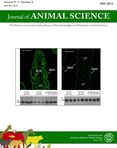-
Views
-
Cite
Cite
L. A. Morrow, T. L. Felix, F. L. Fluharty, K. M. Daniels, S. C. Loerch, Effects of sulfur and acidity on performance and digestibility in feedlot lambs fed dried distillers grains with solubles, Journal of Animal Science, Volume 91, Issue 5, May 2013, Pages 2211–2218, https://doi.org/10.2527/jas.2012-5866
Close - Share Icon Share
ABSTRACT
Negative interactions of the acidity and S content of dried distillers grains with solubles (DDGS) have not been quantified. The objectives of this study were to determine the effects of dietary S, dietary acidity, and their interactions on growth, feed efficiency, ruminal H2S concentration, and apparent nutrient digestibility in lambs fed DDGS-based diets. To neutralize acidity, the DDGS was untreated or treated with 2% NaOH. Dietary S content was adjusted with Na2SO4 to achieve a 0.2 percentage unit difference in dietary S. Experiment 1 included 72 ewe and wether lambs (BW = 24.9 ± 0.4 kg) penned by sex in 24 pens, blocked by BW, and allotted in a 2 × 2 factorial arrangement of treatments for a 60 d feeding trial. On a DM basis, diets were: i) 60% DDGS + 0% Na2SO4, ii) 60% DDGS + 0.88% Na2SO4, iii) 62% NaOH-treated DDGS + 0% Na2SO4, and iv) 62% NaOH-treated DDGS + 0.83% Na2SO4. There were no interactions (P ≥ 0.19) of dietary S concentration and NaOH treatment. Lambs fed DDGS treated with 2% NaOH had 4% greater (P = 0.05) final BW and tended (P ≤ 0.07) to have greater DMI and ADG than lambs fed untreated DDGS; however, NaOH treatment did not affect (P = 0.42) G:F. Increasing dietary S with Na2SO4 tended (P = 0.07) to reduce DMI; however, dietary S did not affect (P > 0.17) ADG, G:F, or final BW. Rumen H2S concentration in gas samples collected on d 32 and 60 were not (P > 0.17) affected by dietary S or NaOH treatment. Experiment 2 included 24 lambs (initial BW = 43.0 ± 4.4 kg) used to determine the effects of NaOH treatment of DDGS and sulfur (Na2SO4) supplementation on N retention and the apparent digestibility of NDF, ADF, and OM. Treatments were similar to those used in Exp. 1, except that dietary DDGS was reduced to 45% of DM. Intake of DM, NDF, ADF, and N was not affected (P > 0.16) by NaOH treatment of DDGS or dietary S (Na2SO4) content. Treating DDGS with 2% NaOH reduced (P = 0.05) NDF digestibility by 10% compared with lambs fed untreated DDGS. Urine pH for lambs consuming DDGS treated with 2% NaOH was increased (P = 0.01) 1.74 pH units compared with urine from lambs fed untreated DDGS. Nitrogen intake and retention were not affected (P > 0.35) by dietary S concentration or NaOH treatment of DDGS. For feedlot lambs, treating DDGS with 2% NaOH did not lower ruminal H2S concentrations, but tended to increase ADG and DMI. Although treating DDGS with 2% NaOH was an effective way to neutralize the acidity in DDGS, this treatment reduced NDF digestibility.





